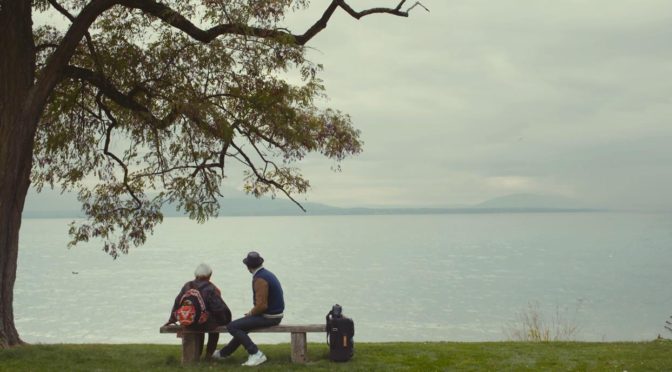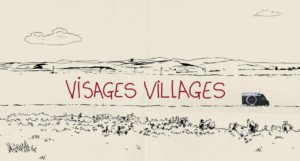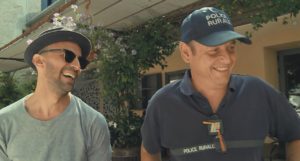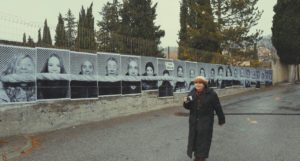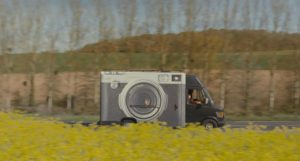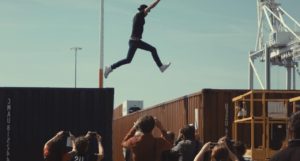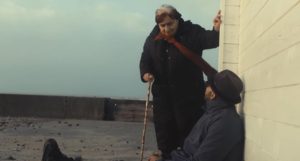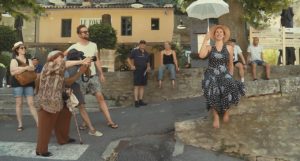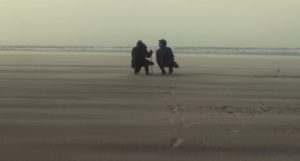I noticed the tiniest, most joyful little detail in my second viewing of Faces Places (or its lovelier French title, Visages Villages), Agnes Varda and JR’s humane, sweetly digressive documentary about meeting and photographing working class folk in France’s small towns. JR, a young visual artist whose calling card is pasting large photographic prints across the fronts of trains, tankers, and large buildings, has set up a scaffold to put up his latest piece of work. A friendly police officer has crossed the street to inform him politely but matter-of-factly that he will need a permit to erect any future scaffolding in this town. JR smiles and shows he understands and then starts joking and conversing with this civil servant. A moment later, Agnes Varda (legendary French director and the thoughtful nonagenarian co-director of this effervescently poetic film) arrives to suggest JR head to a nearby café to meet a beautiful barista who they may want to photograph. In the next beat, JR is in the café meeting the barista. And the officer is there with him! This stranger, who basically just came to check his paper work, is now there right beside JR just merrily tagging along on the errand. This most minute of moments is Faces Places’ soul in miniature, and I also think it points to perhaps the most vital skill a nonfiction filmmaker can possess. One of the most invaluable and often invisible talents that the greatest documentarians have is the ability to draw people into their orbit. You must make people want to be around you and talk to you. A great documentary filmmaker knows how to engage, even with the most shy and taciturn of subjects, to make them feel comfortable and open and ready to bear themselves. Expressing oneself for a camera can be an awkward, uncomfortably intimate thing even for a seasoned actor, and the magic trick of the most brilliant documentaries is to guide a person through that difficult process when they, in all likelihood, are not professional performers. Faces Places finds Agnes Varda and JR to be masters of connecting with the people they interview and you leave each exchange feeling that they have coaxed something deep and true out of their subjects. What makes this one of the most superlative documentaries ever made is how even the most humbly withdrawn subjects they find end their encounter smiling, engaged, and eager to reveal more of themselves. Faces Places is quite possibly the most unabashedly humanistic documentary I have ever seen, and it attains that power because its creators seem to genuinely love people. At the end of a long year, where it felt like a whole lot of human beings distrusted one another as a rule, Faces Places is a reminder that it is in our nature to reach out to one another and need one another. It is a love letter to human beings, working class ones in particular, that positively glows with empathy, curiosity, and affection for humankind.
The first thing to know about Faces Places is that it is an Agnes Varda film. If you are not aware of the 90-year old filmmaker’s past work, take comfort in the fact that this would-be cinephile has not caught up to a single film in her large, influential body of work until now. It is an omission I mean to remedy as soon as I can. For now, it is just important to know that the prolific Varda was a pioneer of the French New Wave, the stylish, energetic, and frequently anarchic film movement led by directors like Jean Luc Godard and Francois Truffaut, which tore down many of the boundaries of classical filmmaking and had a massive impact on a generation of modern filmmakers (Quentin Tarantino and Martin Scorsese among them), who would take inspiration from its innovative, brazen example. Agnes Varda comes from this French pack of rebels, though her rebellious streak is more subtle and contemplative. She is a petite woman with hair that is half-auburn and half white, and she carries herself with a gracious, unfussy candor. At ninety years of age, where many a director might lose their cinematic appetite, Varda is motioning for a dessert menu. In Faces Places, she strikes up an artistic partnership with a 33-year old, sunglass-clad French photographer named JR. The two of them take a fast liking to one another and decide to head out on a loosely structured road trip through the many bucolic villages of rural France. They know each others’ talents (she a filmmaker and he a visual artist) and admire each others’ work. They have an idea that they will go out with a film camera, meet people, shoot their pictures, and the rest, in that oh so nebulous French way, will reveal itself to them along the way. The two new friends set out on their odyssey in JR’s mobile photography studio, a modest vehicle with a camera printed on the side and a small lab in the back. The idea is to head away from Paris and into the villages of the French countryside, where the two mutually admiring artists will mingle with the local populace and practice their respective arts. This involves introducing themselves to people, learning their stories, and using JR’s gift for grand-scale photography to pay tribute to them. In their first encounter, JR blows up photographs of villagers with a baguette between their teeth and stitches them together across a town fence to create what looks like an entire village feasting together on the same long loaf of bread. They travel to a salt processing factory and plaster images of every worker reaching out to one another across a spillway. And, in a tremendously moving scene, they meet a miner’s widow who is the last resident left on a block of abandoned, dilapidated houses, and emblazon her image twenty feet high across the façade of her home. Faces Places is a beautiful, lyrical travelogue of France, surely the finest documentary ever made about photography, and also a sweet, heartfelt ode to modest, hardworking people. It is also about Agnes Varda and JR and their relationship as partners, as cinema-lovers and as friends. It is the story of an older artist who is drawing closer to the end of her life and her meditations on death, art, and legacy. And it is very much about how her dear friendship with this kindly, hip young man colors those ruminations and reflections.
If one line evokes the soul of Faces Places, as well as that of the curious, poetic Varda herself, it is one that comes early in Varda and JR’s discussions about what the film will be. Varda is not concerned about setting out on the road with only the most tenuous of premises. “Chance has always been my best assistant,” she tells JR. Varda began her career as a photographer, and this notion, of never knowing what one will find but being ready for whatever it is, is a vital part of photography. You cannot always control what images will enter the frame, but you know they will come and you wait for them in anticipation. Faces Places is a masterpiece made on the fly. It attains much of its beauty via its invigoratingly flighty spirit, flitting from subject to subject and spinning merrily into sublime digressions. At one point, the film wanders off into a meadow for ten minutes to muse about two opposing schools of thought on goat farming. The genius of the film is that it leads with a spirit of blithely restless wanderlust, yet the end result feels soulfully cohesive. Varda is a brilliant editor and arranger of her own work, and having perfected that skill over decades and decades liberates her and JR to follow a rambling path, knowing that, whatever they find along the way, there will be a story in it. This is not just an approach to documentary filmmaking that Faces Places pulls off with breathless aplomb. It is also of a thematic piece with the film’s journey. Faces Places is very much about opening yourself up to new and unexpected experiences at any age. One of the joys of the film is seeing the vibrant, curious spirits of the subjects they meet. One factory worker stares quizzically at JR’s latest massive photograph. Then he beams and says, “Art is supposed to surprise us, right?” In another small town, they befriend a local farmer who has been in charge of doing his village’s harvesting for many years. Recently, the tractors he uses have had advanced computer technology installed in them. He admits that this makes him something like a passenger in his own job. He reflects that all this technology may be making use more antisocial, less engaged, But still, his overall attitude is one of wonder at progress; at life’s relentless forward motion. He is fascinated by the foreign and new. “I get a kick out of it,” he says with a smile.
Faces Places has a hunger for new sights, new places, and new experiences, but it is even more vitally about opening your mind and soul to other human beings. The film hums with a spirit of adventure and with a yearning to meet, know and love the countless faces that make up our world. It is about the small joys of reaching out and connecting with people and that love for engaging with new people extends to its very creation. Faces Places is simply one of the most lovely odes I have seen to the virtues of collaborating. Varda confesses at the start that this will be her first time really working with a collaborator in over sixty years as a filmmaker. She smiles and enthusiastically notes that this will be a giant leap forward for her. Faces Places gracefully unfolds as not only a film about its humble, hardworking subjects, but also a film about the wonderfully sweet, supportive partnership and friendship that develops between the sage, droll Varda and her spry, affably energetic traveling companion. Varda and JR are kindred spirits and also fascinatingly subtle contrasts to one another. In one scene, the two artists admit that each of them may be performing the roles their different ages have assigned to them: JR, in his sharp fedora and Roy Orbison shades, playing the spirited young man, while the diminutive, elderly Varda adopts the persona of the wise grandmother. JR’s playful presence provides a lovely complement to Varda’s more subdued brand of vivacity, though both brim with a glee for their art; for the process of finding and uncovering human beings. Faces Places is a celebration of collaboration as a process that both synthesizes the visions of multiple creators and also throws their unique differences into relief. It is endlessly joyful watching Varda and JR laugh, bounce ideas, and good-naturedly spar with each other, partly because the film has keen insights about the creative process. But what really makes their collaboration so engaging to watch comes down to the fact that Agnes Varda and JR are simply two of the warmest, most endearing figures to ever stroll across a film screen. They are generous, intelligent, spontaneous, and fun to be around, and they add immeasurably to this teeming, open-hearted tapestry of the very best in humankind.
At its core, Faces Places is about wanting to know people and see them with as much kindness, clarity, and insight as we can. This is the reason the two collaborators head out into the villages of France with little plan in place outside of simply finding people and photographing them. They trust that the desire to just look at humanity will be enough to see the project through, and their faith is more than rewarded. I adore every, warm, kind interaction in this film. However, what transforms Faces Places into a masterpiece of boundless compassion and curiosity is how it slowly evolves into the story of Varda and JR wanting to better know each other. The film’s spirit of vibrant empathy is so contagious that the creators cannot help but turn their cameras upon one another. They join the arc of this ever-developing story, or rather were always a part of it. And I will now need to tread lightly, as I do not want to give away the most poignant, soul-sating, and all around best ending in any 2017 film. One of the documentary’s recurring storylines involves Agnes Varda’s longtime relationship to French New Wave master, firebrand, and petulant genius Jean Luc Godard, a now-distant friend who Agnes has not seen in over five years. With his sophisticated air of cool and the sunglasses he keeps perpetually over his eyes, Agnes sees something of Godard’s enigmatic, confident flair in JR, for better and maybe also for worse. Varda reveres her estranged friend’s talent, but also knows that Godard had a knack for being cutting, aloof, and cruel. In trying to figure out who JR is as a young man just beginning to make his artistic mark on the world, Agnes Varda is also trying to parse what kind of people a new generation of artists will be. They have the shoulders of giants to stand upon, but I believe Varda also hopes for something a bit kinder than certain geniuses of her generation. I think she hopes that that a man like JR will aspire to Godard’s greatness as an artist, but also aspire to be a better all-around human being. In its final moments, Faces Places reveals itself as an effortlessly wise look at aging and legacy and an almost impossibly profound letter of hope passed down from one generation to the next one in line. In a year that seem pockmarked with generational infighting, watching the friendship and artistic kinship that flowers between Agnes Varda and JR over this brief, magical 94 minutes felt absolutely restorative. 2017 had its share of powerful endings, but the closing minute of Faces Places is the one I want to keep with me; the one I want to intermittently steal away to and dwell in. It is a warm embrace between the young and the old, a tender paying of respect to experience, and a sweet expression of confidence and hope for those who will decide what humanity becomes next. Faces Places is a movie about trying to see and understand people and it ends with an exchange of mutual understanding that is too wise and beautiful for words. At the end of 2017’s storm, that final shot is an oasis of selfless calm and fellowship that I could have sat in contentedly for hours.
Faces Places is a film with a vibe both heady and free-wheeling. In many ways it seems like a niche film on paper, being both a subtitled documentary and a reflective essay on variousvcerebral subjects, ranging from cinema to the nature of memory to the psychic weight of place. I suppose it qualifies as an art film, but the pretentious connotations that sometimes go with that label could not be further from this film’s crystal clear aims. I would recommend Agnes Varda and JR’s miraculous documentary to absolutely anyone because it is so thoroughly vivacious, loving, and open. It is filled with beautiful imagery, lovely art, gracious people, and only the purest of emotions. It is funny and friendly and comforting and wistful. And, for all its philosophical musings, it finally just amounts to an open-hearted salute to the very best in people. Because its creators embark upon their journey with such earnest curiosity, playfulness, and kindness toward those around them, they find a country full of people with good hearts and stories just waiting to be unearthed. Faces Places has a lot to say, but one lesson might be that if you go out in search of the good in human beings, you are certain to find it. In one scene, Varda and JR are looking for a parasol to use for their latest photograph. One man they question seems uncertain and a bit hassled by the request, but he obligingly runs off to his parents’ home to see what he can find. He comes back moments later beaming from ear to ear and holding his mother’s old bridal parasol. He proclaims with a proud smile, “You may use it for the photo.” A couple scenes later, he is excitedly pulling JR up to the top of the town’s tower to show off his skills as the village bell-ringer, gushing about how each bell has its own name. My mother always told me that, deep down, people want to be of help to one another and that they want to have their stories heard. You have only to extend a warm hand to them. Faces Places is 2017’s great reminder of this beautiful truth. It is as true in documentary filmmaking as it is in life: kindness and a spirit of gentle curiosity can open worlds before your very eyes.
